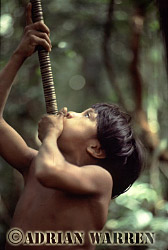WAORANI
The Saga of Ecuador's Secret People:
A Historical Perspective
© Adrian Warren, Last
Refuge Ltd., March 2002, in association with Dr. James Yost
Caempaede's group at Gabado started moving, a
few at a time, to the protectorate at Tewaeno. Soon afterwards, Tagae's
group raided those still remaining at Gabado and, in fear for their lives,
the survivors of Caempaede's group also moved out. It was now 1975, but
after only a short time living in the Protectorate, Caempaede's group
decided that the new lifestyle did not suit them and, in spite of the
continuing danger from Tagae, they returned to their homeland at Gabado,
in 1976. Jim Yost had continued his contact throughout this period and
began his studies. It was an unique opportunity: a chance to observe for
the first time a people who had been isolated for Centuries, and whose
origins were a mystery

Jim Yost with Waorani Children,
1983 |
Unravelling the secrets of Waorani
culture, Jim made some amazing discoveries. He found that the Waorani
had maintained the highest levels of homicide ever recorded in the
annals of human history. Fully fifty per cent of all deaths in the
preceding five generations had been the result of homicide as the
Waorani engaged in a continuous and deadly internal vendetta, pursued
mostly at night, in spearing raids. No death, it seemed, whatever
the cause, went unavenged. Furthermore, the Waorani were even reputed
to kill by spearing any, although only a few instances have been proven,
of their old people who no longer had the means to support themselves;
and they practised infanticide, either strangling unwanted or malformed
babies with vines, or burying them alive. |
Even while Jim was studying the Waorani culture, the
killings, in feuds and raids, continued, although their frequency gradually
reduced due to increasing missionary influence. Apart from their extraordinary
history of homicide, a further twenty per cent of Waorani deaths were caused
by shootings by outsiders; and another five per cent died from snake bites.
Medically, the Waorani turned out to be something of an enigma: they
had no trace of cancer; no cardiovascular disease; no high blood pressure;
no allergies; and none of the known diseases familiar to us. 'Waorani',
in their own language, means 'people'; anyone who is not a Waorani
they call 'Cowode'– savages and cannibals. The Waorani lived
in secrecy, in the hinterlands on hilltops, well away from major rivers
to avoid contact with others. Living under the constant threat of
being raided by war parties, the Waorani kept possessions to a minimum;
they never knew when they might have to flee in the night and re-establish
a home perhaps many days journey away on foot. In case of such an
emergency, they maintained a series of gardens scattered over a huge
territory to give them alternate living sites with food already available.
It was a life of constant fear.
|
 Learning to use a Blowgun,
1983
Learning to use a Blowgun,
1983 |
Six fingers
............ and six toes
|
